No video provided.
Centennial Celebrates
One thing that L.A. is not known for is its prevalence of buildings and institutions that have achieved that rarified status of celebrating a centennial.
Definitely not the first, but one of the most notable to recognize that milestone is the Los Feliz Improvement Association. Founded by William Mead in 1916, it has continuously kept a watchful eye on the community for 100 years. And it shows. It has gone from a rather staid upscale residential community called “Pill Hill” in the 70s because of its proximity to nearby hospitals and homes being sold to doctors to a trendsetting neighborhood populated with notables who appreciate its ambiance, beautiful homes and proximity to Griffith Park.
Several homes in the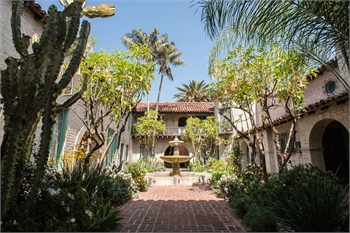 Los Feliz area have reached 100, including the Mead estate, gutted back to its studs and awaiting a buyer. Others include LA Times’ Otis Chandler property large enough for his eight children and the regal home formerly owned by filmdom’s founder, Cecil B. DeMille, in its gated Laughlin Park area. (Right)
Los Feliz area have reached 100, including the Mead estate, gutted back to its studs and awaiting a buyer. Others include LA Times’ Otis Chandler property large enough for his eight children and the regal home formerly owned by filmdom’s founder, Cecil B. DeMille, in its gated Laughlin Park area. (Right)
Not far from Los Feliz’ southern boundary, rests the former home of Mayor James R. Toberman.
Sadly many historic properties have been lost but thanks to the work of Hollywood Heritage, one
such home has been given a new lease on life. Toberman was mayor from 1872 to 1874 and
from 1878 to 1882. He came to Los Angeles in 1864 when President Lincoln appointed him U.S. revenue assessor.
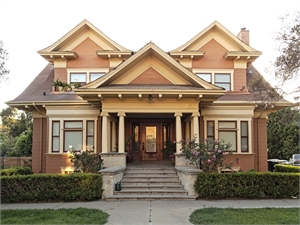 He built his Harvard Boulevard home (Right) in 1907 after creating, with nephew Charles Toberman, the Hollywood Holding Co. That firm, following Toberman’s death in 1911, is credited with developing the Hollywood Roosevelt Hotel, Grauman’s Chinese Theatre, the El Capitan Theatre and the Max Factor Building—all having a few years to go before their own centennials.
He built his Harvard Boulevard home (Right) in 1907 after creating, with nephew Charles Toberman, the Hollywood Holding Co. That firm, following Toberman’s death in 1911, is credited with developing the Hollywood Roosevelt Hotel, Grauman’s Chinese Theatre, the El Capitan Theatre and the Max Factor Building—all having a few years to go before their own centennials.
However, Los Feliz and East Hollywood are relative newcomers compared to Hollywood which has several still standing remnants of the past. The historic Janes House, a Queen Anne era home, that once served as a school for children of Chaplin and DeMille conducted by the sisters Janes, formerly rested right on famed Hollywood Blvd. and has since been moved to the back of the property behind a newer shopping and restaurant
complex.
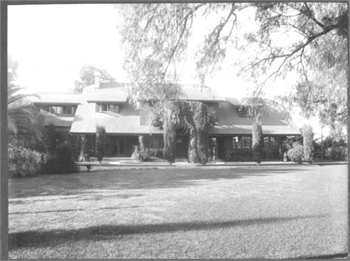
Orchard Gables (above) at Fountain and Wilcox, restored by the Hollywood Community Housing Corporation, and now offices of two non-profits, was named a Historical Cultural Landmark in
2006. Build in 1904, it’s the last remaining residence of a bygone rancho era when U.S. Senator
Cornelius Cole subdivided his property into smaller parcels sold off to gentleman (and women)
farmers arriving to the southland from the Midwest. Another property attributed to Cole, is the Lombardi House (right), now an event site on Bronson just north of Hollywood Blvd., supposedly was used by Cole for his stables. Cole is responsible for the naming of 11 of Hollywood’s most noteworthy streets, including Vine Street which led to his vineyard from his home at the southern end of his 500-acre property.
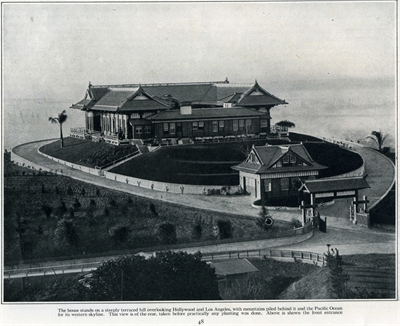 Like many things “Hollywood,” the Magic Castle, formerly the Rowland Estate and the hilltop Yamashiro (left), now a restaurant, already celebrated their centennials before the turn of the last century and the other in 2013. Built to resemble a palace in Kyoto, Japan, by the brothers Bernheimer to house their Asian art collection, it’s famed for gorgeous sunset views at cocktail hour.
Like many things “Hollywood,” the Magic Castle, formerly the Rowland Estate and the hilltop Yamashiro (left), now a restaurant, already celebrated their centennials before the turn of the last century and the other in 2013. Built to resemble a palace in Kyoto, Japan, by the brothers Bernheimer to house their Asian art collection, it’s famed for gorgeous sunset views at cocktail hour.
Melding the old and the new, the home of American Society of Cinematographers (Below), on Orange at Franklin is an outstanding example of Mission Revival architecture. The former residence built in 1905 has been the filmmakers clubhouse since the 30s. Who says that Los Angelenos don’t respect the past?
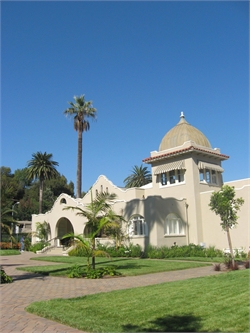
In spite of some difficult times in recent years, the venerable Hollywood Woman’s Club has rebounded with new leadership and a series of events designed to build up its membership. It could be said that there wouldn’t be a Hollywood Bowl without the Woman’s Club who was very instrumental making sure there were plenty of cultural activities available in early Hollywood—especially music
and theatre.
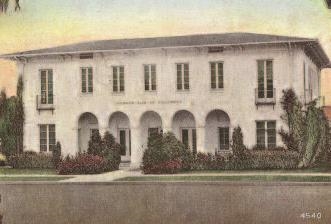 Their “new” clubhouse (Right) on LaBrea built in the 40’s, still is a wonderful venue for weddings, recitals, and gatherings of all kinds. A little further west,
Their “new” clubhouse (Right) on LaBrea built in the 40’s, still is a wonderful venue for weddings, recitals, and gatherings of all kinds. A little further west,
Wattles Mansion, operated by the City of Los Angeles, is also a historic property offered to the public for special events. Situated in a neighborhood, just off Hollywood Boulevard at Curson, residents are sensitive to the number and type of events allowed but, if you’re willing to follow the rules and book far in advance, this location is definitely special. According to Wikipedia, the estate has been recognized as “the only remaining intact example of the once plentiful Hollywood estates from the period preceding the film industry, when Hollywood was primarily agricultural and was a wintering home for wealthy Easterners and Midwesterners.
These are a few of the larger, significant homes. It won’t be long until the many small Craftsman-style homes dotting the streets of Hollywood will be turning 100. No doubt we’ve missed a few and count on our loyal readers to help us build our list. While Hollywood these days seems to be keeping is eyes
on the future, let’s not forget that this community is still firmly rooted in the past and each passing year, more buildings and institutions will join the list.